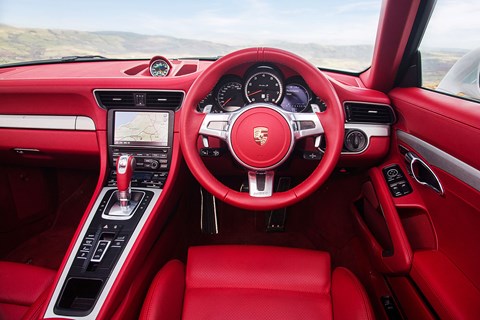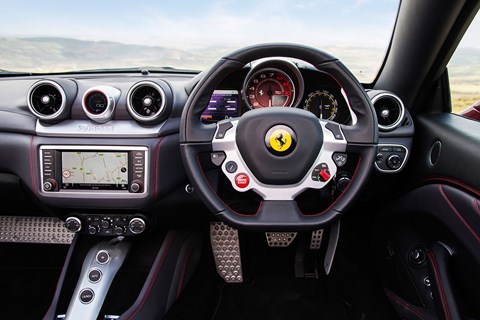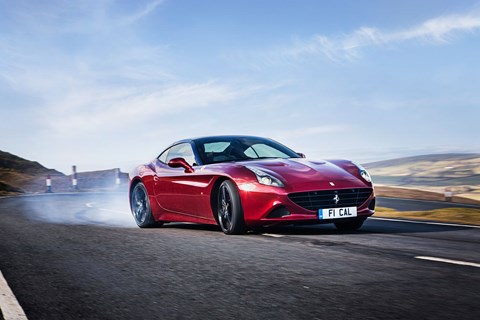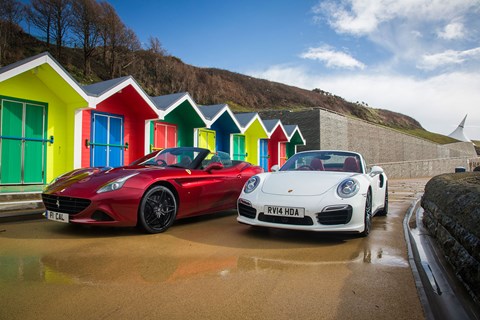► Duelling turbos: battle of the cabrios
► Closely matched for power, price and ethos
► Both have 552bhp, both cost £150k
Imagine both Porsche and Ferrari sheltered under Volkswagen or Fiat’s umbrella. Mostly, they’d be entirely complementary stablemates: Porsches typically sit in the £40-£100k bracket, Ferraris between £175-£225k, so market cannibalisation would be near non-existent.
If CEOs Müller or Marchionne were to have headaches, it’d be at £150k, the only price clash. Barring the 918 there is no costlier Porsche than the 911 Turbo S Convertible, no cheaper Ferrari than the California T, directly comparable convertibles that make exactly 552 ponies and weigh 1750kg, give or take. They also tilt more towards luxury performance than the driver-focused thrills we often associate with both marques.
Suppose you’re Müller or Marchionne, then; which gets the bullet?
In the white corner: Porsche 911 Turbo S Convertible
The 911 Turbo S Convertible fields a 3.8-litre turbocharged flat-six, seven-speed dual-clutch transmission and all-wheel drive. A 911 Turbo costs £121k, removing the roof adds £7500, and appending an S injects 39bhp and 66lb ft extra for 552bhp/553lb ft. It also introduces active anti-roll control, carbon brakes, LED headlights and the Sport Chrono pack with its dynamic engine mounts to get on tippy toes and touch Ferrari territory at £149,668.
All manner of options are available, but our tester gets only Adaptive Cruise Control, black rims, a brushed aluminium gear shifter and assorted nick-nacks to tickle the total to £152,703. Pretty representative, I’d say.
In the red corner: Ferrari California T
The £154,490 Ferrari California T is a comprehensive development of the California. There’s revised styling inspired by the 250 Testa Rossa’s pontoon lines, 15% more interior space, an uprated chassis, faster gearshifts and an all-new engine. It’s also Ferrari’s sole front-engined convertible, the only way for Tifosi to carry four roof-down.
The California T is the first Prancing Horse to go turbo since 1987’s F40 – the 488 GTB comes next – and features a 3.85-litre V8 producing 552bhp and 557lb ft. Like the Porsche, it gets a dual-clutch transmission, but the Ferrari sends power to the rear wheels alone, and there’s only one flavour of California T. Choice instead comes via the options list, and Ferrari has done more box-ticking than a Whitehall bureaucrat. The price swells to £200,628 as a result, highlights including £7k Rosso California Red paint, £4k contrast roof, £4k parking cameras, £3.5k 20-inch rims and £3k audio.
Inside the Porsche 911 Turbo S Convertible

It’s a blustery spring day when we meet at Barry Island, Wales. The holiday resort is out-of-season quiet, but every local is drawn like iron filings to the magnetic Ferrari. The Porsche is almost universally overlooked. Either way, owners may feel aggrieved; I take the chance to familiarise myself with the Porsche.
You sit down low, standard 18-way electric memory seats hugging you comfortably and offering more adjustment than a dentist’s chair. The steering wheel is small, perfectly sculpted at the crucial quarter-to-three interface and disconcertingly multi-functionless, while the centre console – idiosyncratically busy with buttons – rises upwards, offering the Excalibur of gear levers into your left hand. Combined with a relatively high waistline, you feel cocooned, the 911 driving position focused, purposeful.
There’s plush leather, perfect stitching, brushed aluminium trim and build quality born from the Blitz, and the luxury touches you’d expect in this segment are very much in evidence: heated seats, cup holders, sat-nav, Bose sounds, cruise control, parking sensors, all factory-fit.
But first impressions of the 911 at a cruise disappoint. The steering has an 4 unappealing syrupiness up top, there are anodyne noises from the engine, and the lumpen ride quality feels more tectonic than Teutonic. Why, when the Turbo has adaptive suspension, can’t Comfort offer more of it?
Inside the Ferrari California T

The Ferrari is a very different proposition. The seats are surprisingly flat, firm and lacking in support, offer less generous adjustment, and even delicate piano-player fingers will chafe between seat controls and door casings. Where you’re ensconced in the Porsche, the Ferrari’s waistline dips down, inviting you to spill an elbow over the side and bask in sunshine; it subtly changes your mindset as you thumb the starter.
Fit and finish generally feels of high quality, and there’s cruise control, sat-nav, parking sensors, automatic lights and wipers, and electric seats all thrown in, but the fillets of silver trim look easily damaged and too Tin Man for comfort. A manettino dial on the small, button-festooned steering wheel is limited to just three settings, not five – Comfort, Sport, ESC-Off – a little hint that this Prancing Horse is tamer than siblings.
Yet while this is clearly a softer Ferrari, equipment isn’t as generous as the Porsche – no heated seats here – and if you’d just swapped from a Merc SL63 you’d think George Osborne had whipped through the cabin on some mad austerity bender.
Thankfully, a brief urban drive proves more convincing. The California’s 10% swifter, super-light steering imbues spritely immediacy, and road-surface texture transitions from tyres to hands, a reminder that Ferrari retains electro-hydraulic steering where Porsche’s electro-mechanical racks only approach tactility in the GT3. The California also rides with a supple pliancy, and the V8 engine – turbocharged, remember, the killer of sound – makes some promising growls at part-throttle.
Up on the roof: fabric vs hardtop
Initial photography complete, we depart for more challenging terrain in the Brecon Beacons. I jump in the Porsche, and plump grey clouds that just whipped us with hail dart to sea, leaving a bright blue sky overhead.
Press a button and the Turbo S Convertible’s fabric roof drops in around 15 seconds at up to 34mph, which sounds modest but feels like dropping the window on a 747. With windows raised, you’re at the eye of the storm, protected from the bluster.
The advantages of the Porsche’s stow-on-the-go system are clear: you can simply slow to operate the roof, rather than attempting to at the traffic lights, failing and then driving off in what appears to be a sporting scissor-lift.

The 911’s roof doesn’t eat into luggage space when open, which is a moot point given that the Porsche is rear-engined. Instead you’ve got a 115-litre frunk (easily trumped by the Fezza’s 240 litres) and rear seats to store things when you’re not carrying (very) small passengers.
A lightweight magnesium roof frame contributes to a weight penalty of just 70kg compared with the coupe, and helps to retain the 911’s iconic lines. Torsional rigidity is doubtless compromised, but this feels a very together car on some pretty ragged surfaces.
CJ Hubbard’s following in the California, but his roof stays firmly closed. This says nothing of CJ’s tolerance for cold, and everything about Ferrari’s retractable hardtop. Opening the roof obscures the numberplate, presumably explaining why you must park to operate it. It also eats into luggage space, and requires a luggage cover to be in place before it opens; there are more caveats and compromises to this high-speed tan. We timed it at around 20sec to stow.
High-speed handling impressions
At first, negative early impressions of the 911 are bolstered by rowdy tyre roar from the huge rear 305-section tyres. But as we head off the major routes and follow a road that unfurls over the Brecon Beacons, the 911 Turbo S comes alive.
A wallflower at low revs, the flat-six begins to howl charismatically, propelling the Turbo forwards on a tsunami of roaring boost with rolls of thunder when you back off. There’s small if detectable lag, so there’s incredible flexibility and sharp response, and when you dip in and out of the throttle through twisty corners, there are none of the nasty shunts you might expect when the boost suddenly shuts off; there’s a surging, non-linear intensity to this delivery, but it’s also very precise.
Combined with super-quick dual-clutch changes and seven closely stacked gears, there’s always a decent slug of performance on hand.
The 911’s ride also smoothes at speed, and somehow you forget the sticky steering, which starts to feel well-weighted, precise and usefully speedy.

Soon you’re stitching together corners with instinctive fluidity, rolling onto the carbon brakes with their excellent feel and stopping power, dropping multiple cogs on the paddleshifters, then leaning on the front end and squeezing the power early to fast-forward down the next straight.
Rear-wheel steering subtly adds to the agility, and the all-wheel-drive system is surreally sticky, but also satisfyingly rear-biased. If you work the chassis very hard in tighter corners and turn off all electronics, you’d best anticipate the spike of boost that’ll spit you quickly sideways on corner exit.
Up here, on these roads, the Porsche is a point-to-point monster: braking, steering, body control, power, gear shifts, they all just gel to propel you cross-country so quickly even the crows must puzzle that they’d missed a more direct route. Only when you go back to doing what most owners will do, dropping the roof, winding back the pace, do the flaws re-appear. That’s pretty unfortunate, but the high-speed rush leaves you inclined to cut some slack.
I swap into the Ferrari, picking up the pace slowly. Those earlier urban impressions are reinforced, particularly its more tactile steering, composed ride – on £3k optional magneride suspension! – and more characterful engine. If you spend more time wafting than hooning – most owners will – the Ferrari is the choice.
But if you want to uncork more than a handful of those 552 prancing ponies, you could be disappointed.
The engine is technically accomplished, but lacking the raw emotion of the old naturally aspirated V8. You simply cannot feel turbo lag, and the staggered peak torque from third to seventh gear encourages you to chase the 8000rpm redline like we did in the good old days when CO2 was an odourless, naturally occurring gas that plants gulped for fun. The figures bear this out: the Porsche drops its torque pants at 2100rpm, the Ferrari teases you to 4750rpm.

Hence you do less short-shifting in the Ferrari than you do in the Porsche. But ultimately the new, cleaner V8 falls short, because when you do really rev it, the power delivery feels thin, and the sound effects taper off. At high revs, it’s not particularly characterful at all, which happens to be the point where the old 4.3 would soar and wail and come over all F1 car (before they too, were turbocharged, and ruined). At least the gear shifts remain incredibly incisive, and a farty little trill between ratios augments the drama.
The California’s chassis is lowered 10mm and features spring rates some 15% stiffer than before, but still it rolls like a P&O
ferry in a churning sea and you’ll have a family of illegals running for the gaps between arch and body when you try to get back through Calais.
There’s actually a good front end on this car, and plenty of low-speed traction given the significant extra hit of torque, but the very quick steering feels at odds with such a rolly body. Tip it into a corner and you can feel the chassis lag behind, giving a disconnected lack of precision, compromised traction and the need to take numerous nibbles at the steering. Sometimes it’s fun to unstick a car’s rear end, but at high speed and with soft suspension, the Cali just feels alarming. And that’s with the stiffer setting selected.
A still-too-intrusive Sport stability control setting doesn’t help: sprint cross-country and you’ll be constantly thwarted by that wading-through-mud frustration.
The alternative is to turn everything off, but the lack of outright control, amplified by the turbo torque, makes this an often
unappealing proposition.
Verdict
That night, we head back to the hotel, the rain thumping down on bucking B-roads. CJ’s up front in the 911, and I can hear him getting on the throttle early and the Turbo just digging in and powering away. I feel much more hesitant in the Ferrari, and even the awkward wiper buttons on the steering wheel take too much mental capacity when trying to cover ground quickly. In so many ways, the two cars really are polar opposites.
The Porsche is a relatively simple fix: it needs more low-speed comfort and refinement, and its engine and steering could be more characterful. It’s just unfortunate that this is so crucial to typical daily use, and that you need space to tap the Turbo’s brilliance; think about how much of that performance you’ll use before buying.
The California T is more of a conundrum: it isn’t good enough to drive to feel like a true Ferrari, yet that sacrifice isn’t mitigated by levels of luxury you might find in a Mercedes SL. Ferrari has proved it can strike this balance with the incredible F12, a luxury GT with driving dynamics to make you whoop. The California should feel hewn from similar stuff; it doesn’t. But if you’ll only ever use six tenths of the performance and you’re a sucker for attention, there’s a high probability it’ll fit your requirements better than the 911.
For me? 911 Turbo S Convertible gets the nod; California T gets the bullet.